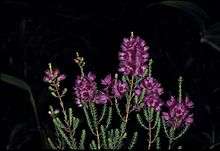Verticordia drummondii
| Verticordia drummondii | |
|---|---|
 | |
| Scientific classification | |
| Kingdom: | Plantae |
| (unranked): | Angiosperms |
| (unranked): | Eudicots |
| (unranked): | Rosids |
| Order: | Myrtales |
| Family: | Myrtaceae |
| Genus: | Verticordia |
| Subgenus: | Eperephes |
| Section: | Verticordella |
| Species: | V. drummondii |
| Binomial name | |
| Verticordia drummondii Schauer[1] | |
Verticordia drummondii is a flowering plant in the myrtle family, Myrtaceae and is endemic to the south-west of Western Australia. It is an erect, openly- to densely-branched shrub with small, narrow leaves and pink to purple flowers in small heads near the ends of the branches.
Description
Verticordia drummondii is a shrub which grows to a height of 30–45 cm (10–20 in) and a spread of 30–75 cm (10–30 in), although sometimes as high as 1.0 m (3 ft) and which has a single, sometimes highly branched stem at its base. Its leaves are narrow egg-shaped, 1.5–3.5 mm (0.06–0.1 in) long with a rounded end but with a very short point.[2]
The flowers are scented and arranged in spike-like groups, each flower on a stalk 1.5–2.0 mm (0.06–0.08 in) long. The floral cup is top-shaped, about 2 mm (0.08 in) long, glabrous with 5 ribs and small green appendages. The sepals are pale to bright pink, 4–5 mm (0.16–0.20 in) long, with 5 to 7 hairy lobes. The petals are erect, pink or white, 3–4 mm (0.1–0.2 in) long, roughly circular in shape with a fringe about 2–2.3 mm (0.08–0.09 in) long. The style is curved, 5–6 mm (0.2–0.2 in) long and has hairs 0.4 mm (0.02 in) long and a slightly enlarged stigma. Flowering time is from December to April.[2]
Taxonomy and naming
Verticordia drummondii was first formally described by Johannes Conrad Schauer in 1840 from a collection made by James Drummond and the description was published in Monographia Myrtacearum Xerocarpicarum.[1][3] The specific epithet (drummondii) honours the collector of the type specimen.[2]
Distribution and habitat
This verticordia grows in sand in low-lying heath and woodland, sometimes in gravelly soil in open woodland. It occurs in near-coastal areas between the Moore River and Mandurah, including the Perth metropolitan area.[2] It is found in the Avon Wheatbelt, Esperance Plains, Geraldton Sandplains and Swan Coastal Plain biogeographic regions.[4][5]
Conservation
Verticordia drummondii is classified as "not threatened" by the Government of Western Australia Department of Parks and Wildlife.[4]
Use in horticulture
This species can be propagated fairly easily from both cuttings and seed and has grown well in a wide range of soil types. Plants grow best in a sunny situation, respond well to pruning and are both drought and moderately frost tolerant. Cultivation in summer-rainfall areas such as Sydney is more difficult.[2]
References
- 1 2 "Verticordia drummondii". APNI. Retrieved 4 June 2016.
- 1 2 3 4 5 Elizabeth A. (Berndt) George; Margaret Pieroni (illustrator) (2002). Verticordia: the turner of hearts (1st ed.). Crawley, Western Australia: University of Western Australia Press. pp. 330–332. ISBN 1-876268-46-8.
- ↑ Schauer, Johannes Conrad (1843). Monographia Myrtacearum Xerocarpicarum. pp. 208–209. Retrieved 4 June 2016.
- 1 2 "Verticordia drummondii". FloraBase. Western Australian Government Department of Parks and Wildlife.
- ↑ Paczkowska, Grazyna; Chapman, Alex R. (2000). The Western Australian flora : a descriptive catalogue. Perth: Wildflower Society of Western Australia. p. 405. ISBN 0646402439.